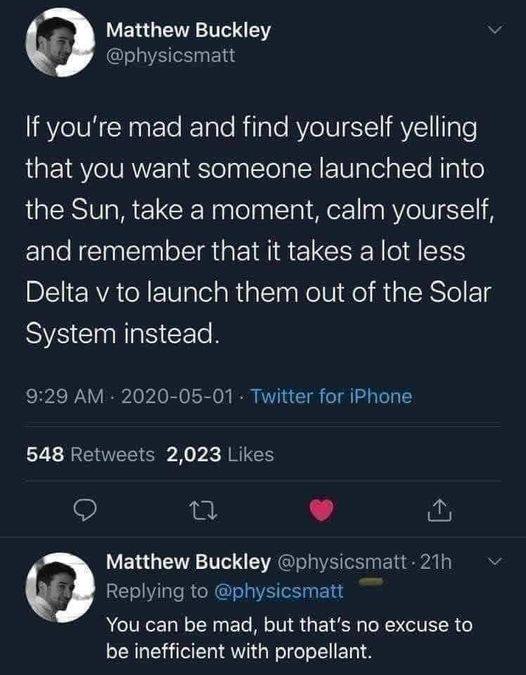this post was submitted on 13 Sep 2024
227 points (97.1% liked)
SpaceflightMemes
688 readers
31 users here now
A Lemmy analogue to r/SpaceXMasterRace.
Related communities for serious posts and discussion.
founded 2 years ago
MODERATORS
you are viewing a single comment's thread
view the rest of the comments
view the rest of the comments

So your saying a stable orbit is easier to achieve than an unstable one? I mean why does nasa higher those math guys. You think putting the helios in a stable solar orbit was more achievable than having them screw up and fall into the sun (again eventually). I see the articles but the supossitions on them are my issue. They seem to be taking an idea of shooting something directly into the sun and not so much allowing something to fall into the sun over a large period of time.
Please recall, the math guys that NASA hired agree with what I'm saying.
https://youtu.be/nSDFkQp-B7Y?feature=shared
Yes, I am saying that the stable orbit that the earth is in, and any number of alternative orbits, are easier to achieve than the extremely small number of possible orbits which intersect the surface of the sun. There are far more orbits that don't touch it than orbits that do. To achieve the specific orbit which does touch it is still possible. You would accomplish it by accelerating to 108,000 km/h opposite of the earth's current orbital velocity.
The word "eventually" carries a lot of your weight in this argument. Technically, eventually, the earth will fall into the surface of the sun. This will happen because the sun expands to become a red giant in 7.5 billion years. The earth will not need to change its orbit to touch the sun, because the sun will reach out to touch it.
https://en.wikipedia.org/wiki/Future_of_Earth
Until then, for the next 7.5 billion years, the orbit of earth and everything on it will remain stable unless acted upon by an outside force. An object in orbit is an object at rest, remaining at rest, following Newton's first law. In its own inertial reference frame, "at rest" means continuing in its stable orbit. To do otherwise would require an equal and opposite reaction, i.e. propellant. This is not controversial.
I mean it sound like we have come to an agreement. It will eventually happen. Granted stable orbits will take much longer. billions of years while an unstable will be pretty quick in cosmic terms. The helios sattelites which were launched and nasa took pains for them not to fall into the sun did so a little after 10 years. That is not very long at all and again its easier to get the orbit that will not survive. So we are talking a few years. Again this is why I find these arguments just dumb because they are looking at the idea of launching the thing directly, again like an arrow, like a bullet, like a laser, into the sun. thats just not necessary.
The Helios probes are still in orbit, they're just not functional
I agree that the idea of launching an object into the sun like an arrow or a bullet is not necessary. I have said so repeatedly. Also, the NASA scientists are correct. You must spend energy to change an orbit. They do not decay spontaneously. I'm happy you can take some comfort in the knowledge that, when the sun grows large enough to smash into the earth - not when the orbit destabilizes - you will in some sense have been correct. Wait long enough, and the sun will fall into you.